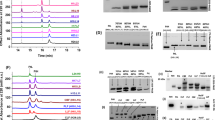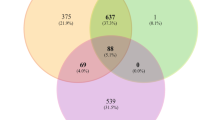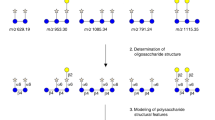Abstract
THE hæmoglobins of mice were first shown to exist in two different inherited forms by Ranney and Gluecksohn-Waelsch1,2 using paper electrophoresis. Their work was confirmed and extended by Russell and Gerald3, who found only two hæmoglobin types, diffuse and single, among twenty inbred lines of mice, using the starch-block technique. Starch-gel electrophoresis gives a better resolution of proteins than either of these techniques, and there have been three accounts4–6 of the detection of slow-moving bands in the diffuse hæmoglobin using starch gel with continuous borate buffer. Popp and St. Amand4 noted these bands and also two peaks in the ultracentrifuge analysis of diffuse hæmoglobin. Ranney, Marlowe-Smith and Gluecksohn-Waelsch5 observed that both the slowest band of the electrophoretic pattern and the faster peak of the ultracentrifuge pattern increased when the hæmoglobin solution was stored for 4 weeks at 4° C. Rosa et al.6 tested six inbred lines, five of which were among those used by Russell and Gerald3, and claimed that they could be further sub-divided into at least four hæmoglobin types, when these bands were taken into account.
This is a preview of subscription content, access via your institution
Access options
Subscribe to this journal
Receive 51 print issues and online access
$199.00 per year
only $3.90 per issue
Buy this article
- Purchase on Springer Link
- Instant access to full article PDF
Prices may be subject to local taxes which are calculated during checkout
Similar content being viewed by others
References
Ranney, H. M., and Gluecksohn-Waelsch, S., Ann. Hum. Genet., 19, 269 (1955).
Gluecksohn-Waelsch, S., Ranney, H. M., and Sisken, B. F., J. Clin. Invest., 36, 753 (1957).
Russell, E. S., and Gerald, P. S., Science, 128, 1569 (1958).
Popp, R. A., and St. Amand, W., J. Hered., 51, 3 (1960).
Ranney, H. M., Marlowe-Smith, G., and Gluecksohn-Waelsch, S., Nature, 188, 212 (1960).
Rosa, J., Schapira, G., Dreyfus, J. C., de Grouchy, J., Mathé, G., and Bernard, J., Nature, 182, 947 (1958).
Poulik, M. D., Nature, 180, 1477 (1957).
Aronsson, T., and Grönwall, A., J. Lab. Clin. Invest., 9, 338 (1957).
Holt, S. B., Ann. Eugen., 12, 220 (1945).
Author information
Authors and Affiliations
Rights and permissions
About this article
Cite this article
MORTON, J. Starch-Gel Electrophoresis of Mouse Hæmoglobins. Nature 194, 383–384 (1962). https://doi.org/10.1038/194383a0
Issue Date:
DOI: https://doi.org/10.1038/194383a0
This article is cited by
-
Allelic constitution of the hemoglobin beta chain in wild populations of the house mouse, Mus musculus
Biochemical Genetics (1985)
-
East asian hemoglobin type (Hbb p) in wild populations of the house mouse in Israel
Biochemical Genetics (1982)
-
Evolutionary trends in the hemoglobins of murine animals
Journal of Biosciences (1980)
-
Simplified typing of mouse hemoglobin (Hbb) phenotypes using cystamine
Biochemical Genetics (1978)
-
Experiments with ?-chain variants of the hemoglobin of Mus musculus
Biochemical Genetics (1977)
Comments
By submitting a comment you agree to abide by our Terms and Community Guidelines. If you find something abusive or that does not comply with our terms or guidelines please flag it as inappropriate.



